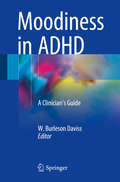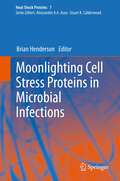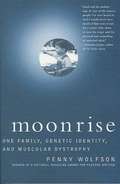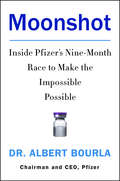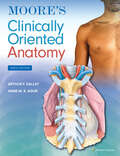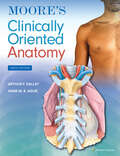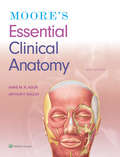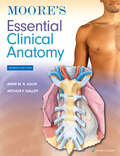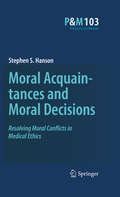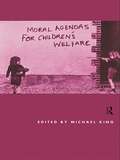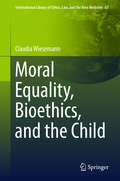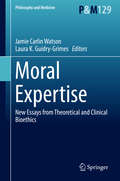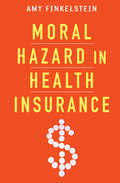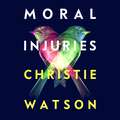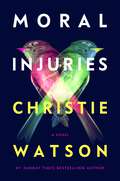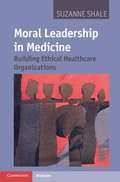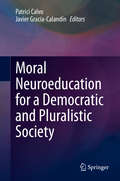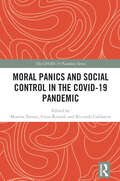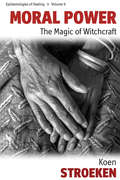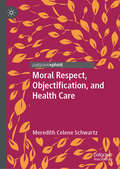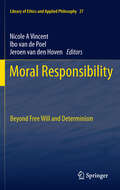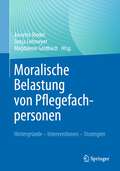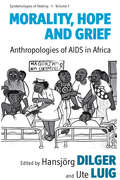- Table View
- List View
Moodiness in ADHD
by W. Burleson DavissThis book gives clinicians a framework and tools to accurately assess moodiness in patients with ADHD, and to provide the most appropriate pharmacological and psychosocial treatments for such problems. This book reviews the assessment and treatment of moodiness in ADHD patients of all ages, but focuses primarily on children and adolescents. Chapters review effective assessment strategies for various potential causes of moodiness in patients with ADHD, then psychosocial and pharmacological treatments and their empirical basis. Specific chapters are devoted to the moodiness characteristic of ADHD itself, and to other disorders co-occurring with it such as disorders of mood, anxiety, trauma-exposure, disruptive behaviors, autism, substance use, and medical problems. The also text includes useful case summaries and tables to illustrate key clinical points useful in working with these patients. Moodiness in ADHD is a potentially vital resource for clinicians wanting to improve their skill working with patients having these challenging problems.
Moonlighting Cell Stress Proteins in Microbial Infections
by Brian HendersonMicrobial infection is increasingly seen as a problem as we begin to run out of antibiotics. Understanding how microbes cause disease is essential. In recent years it has begun to emerge that bacteria, fungi, protozoa and viruses can use their cell stress proteins to cause infection. This volume brings together the world's leading experts in the study of the microbial and human cell stress proteins that are involved in enabling microorganisms to infect humans and cause serious disease.
Moonrise: One Family, Genetic Identity, and Muscular Dystrophy
by Penny WolfsonIn this riveting and thought-provoking memoir about her family, her son Ansel, and his progressive disability, Penny Wolfson embarks on a quest that explores special education, giftedness, prenatal testing, and the genes she shares with her mother, sisters, and son. While Moonrise is an eloquent narrative of one family, it also asks profound questions about our genetic selves.
Moonshot: Inside Pfizer's Nine-Month Race to Make the Impossible Possible
by Dr. Albert Bourla2022 Genesis Prize LaureateThe exclusive, first-hand, behind-the-scenes story of how Pfizer raced to create the first Covid-19 vaccine, told by Pfizer’s Chairman and CEO Dr. Albert Bourla.A riveting, fast-paced, inside look at one of the most incredible private sector achievements in history, Moonshot recounts the intensive nine months in 2020 when the scientists at Pfizer, under the visionary leadership of Dr. Albert Bourla, made “the impossible possible”—creating, testing, and manufacturing a safe and effective Covid-19 vaccine that previously would have taken years to develop. Dr. Bourla chronicles how the brilliant, dedicated minds at Pfizer, under the enormous strains of the global pandemic, overcame a series of crises that were compounded by social and political unrest, and reveals the doubts, decisions, obstacles, and failures they encountered. As Dr. Bourla makes clear, Pfizer’s success wasn’t due to luck; it was because of preparation driven by four simple values—Courage, Excellence, Equity, and Joy.Moonshot is a story of leadership under the most unprecedented circumstances—how Dr. Bourla, a Greek immigrant, a child of Holocaust survivors, and a veterinarian, became the head of one of the world’s largest corporations and initiated a dramatic transformation of the organization just before a global health crisis would serve to test the organization, its scientists, and its leader, like never before. Moonshot describes best practices that can be used to address the multiple, unprecedented challenges our world faces, reveals Pfizer’s implementation of scientific breakthroughs at a record-breaking pace, and offers leadership lessons that can help anyone successfully manage their own seemingly unsolvable problems. As Dr. Bourla explains, “I am sharing the story of our moonshot—the challenges we faced, the lessons we learned, and the core values that allowed us to make it happen—in hopes that it might inspire and inform your own moonshot, whatever that may be.”
Moore's Clinically Oriented Anatomy
by Anne M. R. Agur Arthur F. Dalley IIRenowned for its comprehensive coverage and engaging, storytelling approach, the bestselling Moore’s Clinically Oriented Anatomy, 9th Edition, guides students from initial anatomy and foundational science courses through clinical training and practice. A popular resource for a variety of programs, this proven text serves as a complete reference, emphasizing anatomy that is important in physical diagnosis for primary care, interpretation of diagnostic imaging, and understanding the anatomical basis of emergency medicine and general surgery. The 9th Edition reflects the latest changes in the clinical application of anatomy as well as preparation for the USMLE while maintaining the highest standards for scientific and clinical accuracy.
Moore's Clinically Oriented Anatomy (Lippincott Connect)
by Anne M. R. Agur Arthur F. Dalley IIRenowned for its comprehensive coverage and engaging, storytelling approach, the bestselling Moore’s Clinically Oriented Anatomy, 9th Edition, guides students from initial anatomy and foundational science courses through clinical training and practice. A popular resource for a variety of programs, this proven text serves as a complete reference, emphasizing anatomy that is important in physical diagnosis for primary care, interpretation of diagnostic imaging, and understanding the anatomical basis of emergency medicine and general surgery. The 9th Edition reflects the latest changes in the clinical application of anatomy as well as preparation for the USMLE while maintaining the highest standards for scientific and clinical accuracy. NEW! Sex and gender content clarifies important gender considerations and reflects an equitable focus on female as well as male anatomy. Updated medical imaging and integrated surface anatomy within each chapter clearly demonstrates the relationship between anatomy, physical examination, and diagnosis. Extensively revised Clinical Blue Boxes highlight the practical applications of anatomy, accompanied by helpful icons, illustrations, and images that distinguish the type of clinical information covered. Updated introduction establishes the foundational understanding of systemic information and basic concepts essential to success from the classroom to the dissection lab. Revised comprehensive surface anatomy photographs ensure accurate, effective physical examination diagnoses with integrated natural views of unobstructed surface anatomy and illustrations superimposing anatomical structures with landmarks for more accurate physical examination. Insightfully rendered, anatomically accurate illustrations, combined with many photographs and medical images, strengthen comprehension of anatomical concepts and retention of “mental images” of anatomical structures. Bottom Line boxes provide detailed summaries at a glance and underscore the “big-picture” perspective. Illustrated tables clarify complex information about muscles, veins, arteries, nerves, and other structures for easy study and review. Chapter outlines help students find key information quickly and efficiently.
Moore's Essential Clinical Anatomy
by Anne M. R. Agur Arthur F. Dalley IIPublisher's Note: Products purchased from 3rd Party sellers are not guaranteed by the Publisher for quality, authenticity, or access to any online entitlements included with the product. Moore’s Essential Clinical Anatomy, Sixth Edition, presents core anatomical concepts in a concise, student-friendly format. As with the leading, comprehensive Clinically Oriented Anatomy text, this succinct resource is widely acclaimed for the relevance of its clinical correlations, emphasizing anatomy essential to physical diagnosis for primary care, interpretation of diagnostic imaging, and understanding the anatomical basis of emergency medicine and general surgery. The text’s hallmark blue Clinical Boxes highlight the practical value of anatomy, accompanied by extensive surface anatomy and medical imaging features that clarify key concepts and structures to help build clinical confidence and equip students for success in practice.
Moore's Essential Clinical Anatomy
by Anne M. R. Agur Arthur F. DalleyKnown for its hallmark Clinical Blue Boxes, Moore’s Essential Clinical Anatomy, 7th Edition, combines an easy-to-read approach, dynamic surface anatomy and medical imaging features, and engaging digital resources to build clinical confidence and equip users for success from foundational science courses through clinical training and practice. The concise, user-friendly format emphasizes structures and functions critical to physical diagnosis for primary care, interpretation of diagnostic imaging, and understanding the anatomical basis of emergency medicine and general surgery. This updated 7th Edition reflects the latest clinical perspectives and is supported by valuable self-assessment tools, case studies, and interactive BioDigital software to enrich understanding for students and practitioners alike.
Moral Acquaintances and Moral Decisions
by Stephen S. HansonThe potential of modern medicine in a pluralistic world leads to the potential for moral conflict. The most prevalent bioethical theories often either overestimate or underestimate the amount of shared moral belief that can be used to address those conflicts. This work presents a means for taking seriously the pluralism in the modern world while recognizing the likelihood of moral "acquaintance" between persons with differing views. It criticizes moral theories that overstate the extent of the problem of pluralism as well as those that imply too much agreement between reasonable moral persons, yet it locates a means for the resolution of many moral conflicts in moral acquaintanceship. Drawing from the work of H. Tristram Engelhardt, Jr., casuists and principle-based theorists, and Erich Loewy and Kevin W. Wildes's initial development of the concept of moral acquaintanceship, Moral Acquaintances and Moral Decisions is philosophically indepth work with direct applications for decisionmaking in real medical settings. A work in moral theory as well as a source of real world guidance, clinically oriented bioethics professionals as well as students of bioethical theory should find the theory of moral acquaintanceship provided here important to their work.
Moral Agendas For Children's Welfare
by Michael KingMoral Agendas for Children's Welfare examines the roles played by politics, religion, ethics, aesthetics, law and science in identifying children's needs and rights and critically analyses existing child welfare policies.Five sections cover the following Agendas:* Philosophical and Psychoanalytical* Psychological and Sociological* Religious * Social Policy* Child Protection.Moral Agendas for Children's Welfare will provide invaluable reading for students in law, social work and policy and sociology and professionals in welfare, health care and law.
Moral Equality, Bioethics, and the Child
by Claudia WiesemannPresenting real life cases from clinical practice, this book claims that children can be conceived of as moral equals without ignoring the fact that they still are children and in need of strong family relationships. Drawing upon recent advances in childhood studies and its key feature, the 'agentic child', it uncovers the ideology of adultism which has seeped into much what has been written about childhood ethics. However, this book also critically examines those positions that do accord moral equality to children but on grounds not strong enough to support their claim. It lays the groundwork for a theory of moral equality by assessing the concepts of parenthood, family, best interest, paternalism, and, above all, autonomy and trust which are so important in envisioning what we owe the child. It does not only show how children - like adults - should be considered moral agents from infancy but also how ethical theories addressing adults can significantly profit from recognizing this. The analysis takes into account contributions from European as well as American scholars and makes use of a wide range of ethical, psychological, cultural, and social-scientific research.
Moral Expertise: New Essays From Theoretical And Clinical Bioethics (Philosophy and Medicine #129)
by Jamie Carlin Watson Laura K. Guidry-GrimesThis collection addresses whether ethicists, like authorities in other fields, can speak as experts in their subject matter. Though ethics consultation is a growing practice in medical contexts, there remain difficult questions about the role of ethicists in professional decision-making. Contributors examine the nature and plausibility of moral expertise, the relationship between character and expertise, the nature and limits of moral authority, how one might become a moral expert, and the trustworthiness of moral testimony. This volume engages with the growing literature in these debates and offers new perspectives from both academics and practitioners. The readings will be of particular interest to bioethicists, clinicians, ethics committees, and students of social epistemology. These new essays promise to advance discussions in the professionalization and accreditation of ethics consultation.
Moral Hazard in Health Insurance (Kenneth J. Arrow Lecture Series)
by Amy FinkelsteinMoral hazard—the tendency to change behavior when the cost of that behavior will be borne by others—is a particularly tricky question when considering health care. Kenneth J. Arrow's seminal 1963 paper on this topic (included in this volume) was one of the first to explore the implication of moral hazard for health care, and Amy Finkelstein—recognized as one of the world's foremost experts on the topic—here examines this issue in the context of contemporary American health care policy. Drawing on research from both the original RAND Health Insurance Experiment and her own research, including a 2008 Health Insurance Experiment in Oregon, Finkelstein presents compelling evidence that health insurance does indeed affect medical spending and encourages policy solutions that acknowledge and account for this. The volume also features commentaries and insights from other renowned economists, including an introduction by Joseph P. Newhouse that provides context for the discussion, a commentary from Jonathan Gruber that considers provider-side moral hazard, and reflections from Joseph E. Stiglitz and Kenneth J. Arrow.
Moral Hazard in Health Insurance (Kenneth J. Arrow Lecture Series)
by Amy FinkelsteinAddressing the challenge of covering heath care expenses—while minimizing economic risks. Moral hazard—the tendency to change behavior when the cost of that behavior will be borne by others—is a particularly tricky question when considering health care. Kenneth J. Arrow&’s seminal 1963 paper on this topic (included in this volume) was one of the first to explore the implication of moral hazard for health care, and Amy Finkelstein—recognized as one of the world&’s foremost experts on the topic—here examines this issue in the context of contemporary American health care policy. Drawing on research from both the original RAND Health Insurance Experiment and her own research, including a 2008 Health Insurance Experiment in Oregon, Finkelstein presents compelling evidence that health insurance does indeed affect medical spending and encourages policy solutions that acknowledge and account for this. The volume also features commentaries and insights from other renowned economists, including an introduction by Joseph P. Newhouse that provides context for the discussion, a commentary from Jonathan Gruber that considers provider-side moral hazard, and reflections from Joseph E. Stiglitz and Kenneth J. Arrow. &“Reads like a fireside chat among a group of distinguished, articulate health economists.&” —Choice
Moral Injuries
by Christie WatsonFrom the Sunday Times bestselling and award-winning author Christie Watson, comes a heart-pounding new psychological drama of secrets, lies, morals and medicine.'Unique and compelling' ELIZABETH DAY 'True literary perfection' EMMA JANE UNSWORTH'Heart-stopping, twisting, funny and frightening' CHRIS WHITAKER'Enthralling, gripping, deliciously dark... An immersive, unforgettable gem' RACHEL CLARKE'Propulsive, funny and filled with suspense'SARAH LANGFORDYou're trained to save the lives of others. How far would you go to protect your own? Ruthlessly ambitious Olivia, anxious perfectionist Laura and free-spirited risk-taker Anjali couldn't be more different. Yet their friendship, which began on the first day of medical school, has kept them inseparable for twenty-five years. As wild all-nighters and exam pressures gave way to the struggles and joys of new motherhood and intense jobs, their bond remained unbreakable. Years ago they promised that nothing would come between them and that they'd do anything for one another, including burying one night they have never spoken about: a drug-fuelled university party that forced them to make a deadly choice that could still destroy them. When an eerily similar tragedy strikes involving their teenage children, everything the three women have built threatens to shatter around them. And they are left asking: just how far can you stretch a friendship before it snaps?'Each new twist screeches like nails on plaster'KATHRYN MANNIX'Where medicine meets morality... with page-turning twists' NATHAN FILER'Intelligent, propulsive and disturbing... I couldn't put it down' NIKKI SMITH'An extraordinary book'JOHN SUTHERLAND'No-one writes about the drama of medicine like Christie Watson'DR GAVIN FRANCIS
Moral Injuries
by Christie Watson'Compulsively readable' SUNDAY TIMES'A superior medical thriller' GUARDIAN'Darkly gripping' OBSERVERYou're trained to save the lives of others. But how far would you go to save your own?Olivia, Laura and Anjali couldn't be more different. Inseparable since the first day of medical school, their bond has remained unbreakable. Years ago, they promised nothing would come between them - including the wild university party that forced them to make a deadly choice.Now working as doctors in high-pressure jobs, with lives and families of their own, their secret binds them tighter still. But when an eerily similar tragedy affects their teenage children, the choice the three women face may not be one their friendship can survive . . .
Moral Injuries: A Novel
by Christie Watson“Heart-pounding. Soul-wrenching. A psychological thriller that dives into the dark beauty and madness of medicine. What a catharsis to see women bound by friendship and love and ambition peel away the layers of who they are at work. We see them bare their teeth and their souls. It is Big, Little Lies meets Grey’s Anatomy in this delicious and satisfying mystery about friendship, love, and why we choose the work we do. Christie Watson has written a masterpiece.”—Kate Bowler, New York Times bestselling author of Everything Happens for a Reason (and Other Lies I’ve Loved)From the author of the smash UK bestseller The Language of Kindness comes an electrifying, high-stakes literary thriller following three best friends since medical school and the twenty-five-year-old secret that now threatens to shatter their lives.When you're trained to protect the lives of others, how far will you go to protect your own?Ruthlessly ambitious Olivia, anxious perfectionist Laura, and free-spirited risk-taker Anjali couldn’t be more different. Yet their friendship—which began the first day of medical school—has kept them inseparable these past twenty-five years. As wild all-nighters and exam pressure gave way to the struggles and joys of new motherhood and new jobs, their unbreakable bond helped them support each other through it all.Long ago, they promised that nothing would come between them, and to do anything for one another—including burying that night they have never spoken about: a university party fueled by drugs, sex, and secrets that forced them to make a deadly choice that could have destroyed them. But is there a limit to what we would do for those we love?When an eerily similar tragedy strikes involving the women’s teenaged children, everything the three friends have built threatens to crumble around them . . . forcing them to decide how far they can stretch their friendship before it snaps.A taut and explosive novel about loyalty, ambition, betrayal, and revenge, Moral Injuries explores the sometimes-hidden costs of friendships, and the lengths people will go to protect themselves.
Moral Leadership in Medicine
by Suzanne ShaleWhat are the moral challenges that confront doctors as they manage healthcare institutions? How do we build trust in medical organisations? How do we conceptualize moral action? Based on accounts given by senior doctors from organisations throughout the UK, this book discusses the issues medical leaders find most troubling and identifies the moral tensions they face. Moral Leadership in Medicine examines in detail how doctors protect patients' interests, implement morally controversial change, manage colleagues in difficulty and rebuild trust after serious medical harm. The book discusses how leaders develop moral narratives to make sense of these situations, how they behave while balancing conflicting moral goals and how they influence those around them to do the right thing in difficult circumstances. Based on empirical ethical analysis, this volume is essential reading for clinicians in leadership roles and students and academics in the fields of healthcare management, medical law and healthcare ethics.
Moral Neuroeducation for a Democratic and Pluralistic Society
by Patrici Calvo Javier Gracia-CalandínThis book brings together a group of top scholars on ethics and moral neuroeducation to cover the specific field of moral learning. Although there are many studies on neural bases of human learning and the application processes in different fields of human activity, such as education, economics or politics, very few of them have delved into the specific field of moral learning. This book brings forward a discursive and cordial ethical concept suitable for the theoretical-practical development of moral neuroeducation, as well as a set of guidelines for the design of an educational model that, based on moral neuroeducation, contributes to the resolution of social problems and the eradication of undesirable patterns and behaviors such as hate speech, corruption, intolerance, nepotism, aporophobia or xenophobia. Furthermore it contains a management approach for the application of this educational model to the different areas of activity involved in social and human development. A must read for students, educators and researchers in the field of moral philosophy, (applied) ethics ethics and any other discipline working with reciprocity (economics, politics, health, etc.).
Moral Panics and Social Control in the COVID-19 Pandemic (The COVID-19 Pandemic Series)
by Morena Tartari Cirus Rinaldi Riccardo CaldareraMoral Panics and Social Control in the COVID-19 Pandemic presents a series of case studies which focus on particular social processes and interactions during the COVID-19 pandemic, applying the tools offered by classical studies on moral panic and moral panic theory to illuminate both political and popular responses.Each case study explores the emergence, development, and impact of forms of moral panic in response to the coronavirus outbreak. In doing so, each chapter addresses the intersectional impact of moral panics upon vulnerable and/or stigmatized groups and outlines how moral panics have informed policies, interventions, and social mechanisms introduced by governments. Incorporating case studies from across the globe and drawing upon approaches from different disciplines, the chapters in this volume offer a wide-ranging and multi-faceted analysis of the varying responses to the coronavirus outbreak.The book highlights aspects of interest for students and scholars in the social sciences, educators, policymakers, and practitioners with an interest in moral panics, responses to the COVID-19 pandemic, and mechanisms of social control.
Moral Power
by Koen StroekenNeither power nor morality but both. Moral power is what Sukuma farmers in Tanzania in times of crisis attribute to an unknown figure they call their witch. A universal process is involved, as much bodily as social, which obstructs the patient's recovery. Healers turn the table on the witch through rituals showing that the community and the ancestral spirits side with the victim. In contrast to biomedicine, their magic and divination introduce moral values that assess the state of the system and that remove the obstacles to what is taken as key: self-healing. The implied 'sensory shifts' and therapeutic effectiveness have largely eluded the literature on witchcraft. This book shows how to comprehend culture other than through the prism of identity politics. It offers a framework to comprehend the rise of witch killings and human sacrifice, just as ritual initiation disappears.
Moral Respect, Objectification, and Health Care
by Meredith Celene SchwartzThis book fills an important gap in existing health care ethics literature by describing an egalitarian conception of moral respect which applies to autonomous and non-autonomous patients alike. It reframes questions about respect, from its target to the role that respect plays in our moral lives. Taking into account various forms of objectification, it suggests that the unique role of moral respect is to recognize a person as more than a mere object; to recognize them as an equally intrinsically valuable being who possesses dignity. Further, the book argues that respect is central to health care because medicine and experiences of illness are both inherently objectifying. Objectification is sometimes morally permissible, and other times morally troubling—a context of respect can help to distinguish between these situations. Because we can reduce others to mere objects in ways other than violating or denying their autonomy, the approach presented here can also accommodate non-autonomous patients directly without considering them as marginal cases.
Moral Responsibility
by Ibo van de Poel Jeroen Van Hoven Nicole A. VincentIt is well over a decade since John Fischer and Mark Ravizza - and before them, Jay Wallace and Daniel Dennett - defended responsibility from the threat of determinism. But defending responsibility from determinism is a potentially endless and largely negative enterprise; it can go on for as long as dissenting voices remain, and although such work strengthens the theoretical foundations of these theories, it won't necessarily build anything on top of those foundations, nor will it move these theories into new territory or explain how to apply them to practical contexts. To this end, the papers in this volume address these more positive challenges by exploring how compatibilist responsibility theory can be extended and/or applied in a range of practical contexts. For instance, how is the narrow philosophical concept of responsibility that was defended from the threat of determinism related to the plural notions of responsibility present in everyday discourse, and how might this more fine-grained understanding of responsibility open up new vistas and challenges for compatibilist theory? What light might compatibilism shed, and what light might be shed upon it, by political debates about access to public welfare in the context of responsibility for one's own health, and by legal debates about the impact of self-intoxication on responsibility. Does compatibilist theory, which was originally designed to cater for analysis of individual actions, scale to scenarios that involve group action and collective responsibility -- e.g. for harms due to human-induced climate change? This book's chapters deal with a range of theoretical problems discussed in classic compatibilist literature -- e.g. the relationship between responsibility and capacity, the role of historical tracing in discounting the exculpatory value of incapacities, and the justifiability of retributive punishment. But instead of motivating their discussions by focusing on the alleged threat that determinism poses to responsibility, these chapters' authors have animated their discussions by tackling important practical problems which crop up in contemporary debates about responsibility.
Moralische Belastung von Pflegefachpersonen: Hintergründe – Interventionen – Strategien
by Annette Riedel Sonja Lehmeyer Magdalene GoldbachMitarbeitende moralisch entlasten!Dieses Buch richtet sich an Führungspersonen und Lehrende im Pflegebereich sowie Ethik-Verantwortliche und zeigt, wie moralische Belastungen sich auf Pflegefachpersonen, deren persönliches Empfinden und letztlich auf den pflegerischen Versorgungsprozess und die Einrichtungen des Gesundheitswesens auswirken.Neben Auslösern moralischen Belastungserlebens werden insbesondere die Entstehung und Wirkung des Phänomens thematisiert sowie Maßnahmen zur Entlastung und Prävention aufgezeigt.Die Interventionen und Strategien beziehen sich auf Pflegefach-, Führungspersonen und organisationsethische Veränderungsbedarfe. Der damit einhergehende Bildungsbedarf wird ebenfalls aufgegriffen und rundet die Perspektiven auf das Thema ab. Ziel ist es, durch präventive und moralisch entlastende Maßnahmen die moralische Integrität und die Berufszufriedenheit der Pflegefachpersonen zu stärken sowie den Berufsverbleib und die Pflegequalität zu sichern.
Morality, Hope And Grief
by Ute Luig Hansjorg DilgerThe HIV/AIDS epidemic in sub-Saharan Africa has been addressed and perceived predominantly through the broad perspectives of social and economic theories as well as public health and development discourses. This volume however, focuses on the micro-politics of illness, treatment and death in order to offer innovative insights into the complex processes that shape individual and community responses to AIDS. The contributions describe the dilemmas that families, communities and health professionals face and shed new light on the transformation of social and moral orders in African societies, which have been increasingly marginalised in the context of global modernity.
